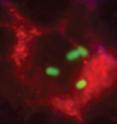Rare immune cell is asset and liability in fighting infection
The same trait that makes a rare immune cell invaluable in fighting some infections also can be exploited by other diseases to cause harm, two new studies show. In papers published online in Immunity, scientists at Washington University School of Medicine in St. Louis reveal that the cells, known as CD8 alpha+ dendritic cells (CD8a+ DCs), can help the body beat back infection by a common parasite, but the same cells can be hijacked by a bacterium to decimate the body's defenses.
The trait that makes the cells both an asset and a liability is the way they alert other immune cells, causing them to attack invaders. CD8a+ DCs can sound the alarm in a manner that is particularly helpful for stripping away invaders' disguises. But this process takes time, and Listeria bacteria can take advantage of that delay to wreak havoc inside the spleen.
"As we've discovered how useful these cells can be in fighting different kinds of infections, researchers have wondered why they're so rare," says Kenneth Murphy, MD, PhD, the Eugene L. Opie First Centennial Professor of Pathology and Immunology. "This may be why -- overcommitting to any one defensive strategy opens up opportunities for counterstrategies that exploit it."
CD8a+ DCs make up about 10 percent of all dendritic cells in the body. By studying the basic functions of these cells, scientists are laying the groundwork to use them to fight infections. The cells also appear to be essential for some cancer vaccines, which enlist the power of the immune system to help fight tumors.
Murphy, who is a Howard Hughes Medical Institute Investigator, previously created genetically altered mice where CD8a+ DCs could be selectively eliminated. By comparing these mice with normal mice, Murphy and his collaborators have shown that CD8a+ DCs are essential to priming the body's defenses against viral infections.
Viruses often try to disguise themselves to evade defenders, but CD8a+ DCs can extract characteristic parts of a virus and display them on their surface. Other cells also can make these displays, but CD8a+ DCs do it in a way that helps peel back disguises, causing other immune cells to seek out additional copies of the virus and kill them.
In one of the new studies, doctoral student Mona Mashayekhi showed that CD8a+ DCs are early responders to infection with the Toxoplasma gondii parasite, which causes serious disease in patients with weakened or suppressed immune systems. She found only CD8a+ DCs produce a signal that causes other immune cells to fight the parasite.
In the second paper, Brian Edelson, MD, PhD, assistant professor of pathology and immunology, tested the cells against the bacteria Listeria, which can cause food poisoning. He discovered that CD8a+ DCs could make Listeria infection worse.
"Listeria likes to get into immune cells using a pathway that typically leads to the bacteria's death in garbage disposals inside the cell," Murphy explains. "But that pathway is slowed down in CD8a+ DCs to ensure that they can retain part of the invader to display to other immune cells."
Researchers watched Listeria use this delay to ride inside CD8a+ DCs as they entered the spleen, where immune cells not yet activated for attacking invaders are kept. These cells are easy targets for the bacteria, and infection worsens.
According to Murphy, CD8a+ DCs' specialized ability to initiate immune attacks makes them essential for efforts to create cancer vaccines based on DNA from tumors. He and collaborator William Gillanders, MD, professor of surgery, are working to use these vaccines to make immune cells attack cancers.
"What we're learning from basic studies, for example, has already enabled us to increase the number of CD8a+ DCs in mice until they're about 30 to 40 percent of dendritic cells," Murphy says. "Learning more about how this cell interacts with other immune cells will allow us to create effective cancer vaccines."
Source: Washington University School of Medicine
Other sources
- Rare immune cell is asset and liability in fighting infectionfrom Science DailySun, 28 Aug 2011, 2:30:15 UTC
- Rare immune cell is asset and liability in fighting infectionfrom PhysorgFri, 26 Aug 2011, 21:30:21 UTC
